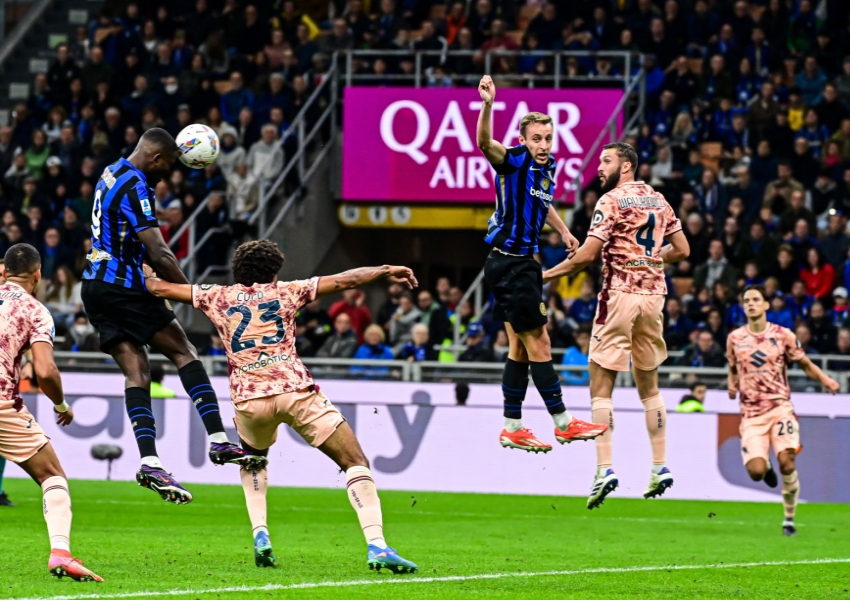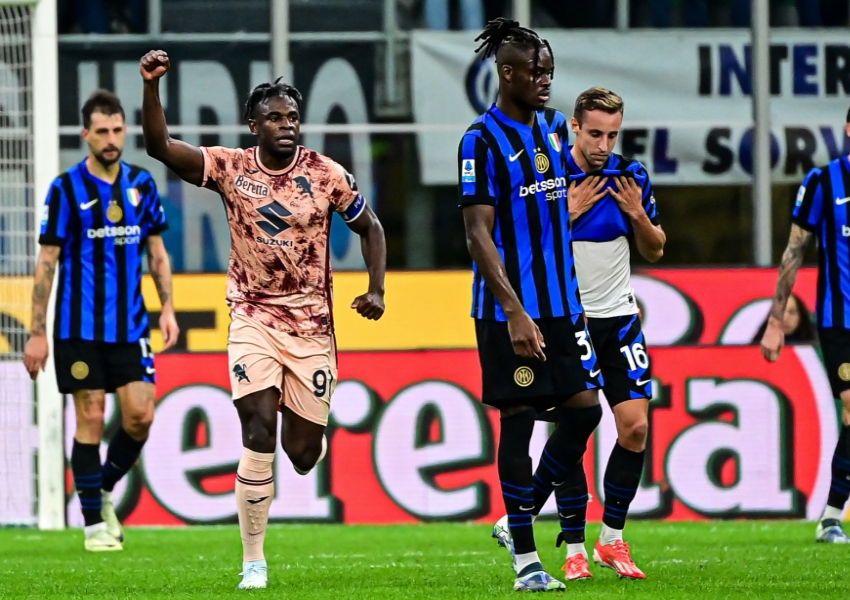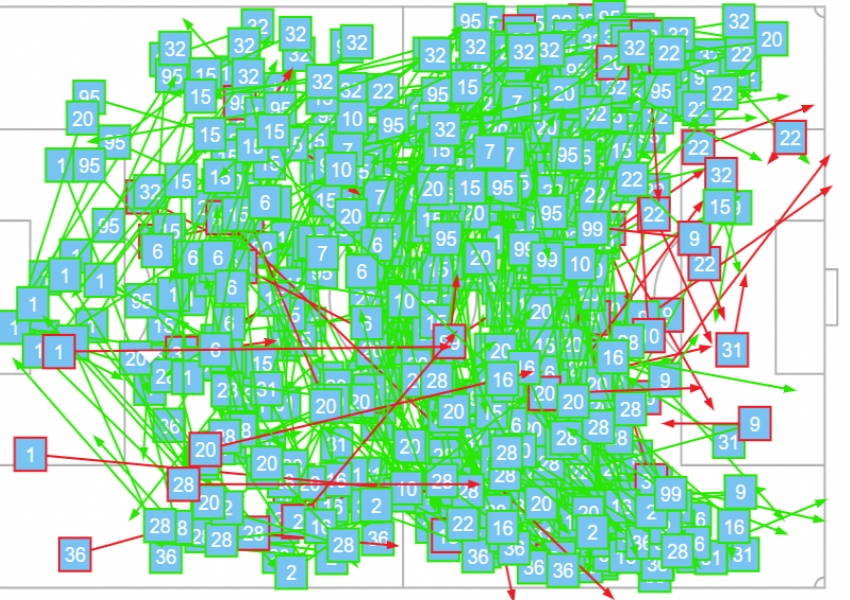Inter Milan's Double-Edged Sword: The Chaos of "All-Out Attack 2.0"
Inter Milan’s recent performances highlight the complexities of their approach under Simone Inzaghi, with a strategy that appears as much a double-edged sword as it is effective. After a thrilling 3-2 win over Torino, Inter secured a third consecutive victory across all competitions, adding to their growing momentum. Marcus Thuram’s resurgence is a key bright spot, but the defensive frailties that have plagued the team in their last few matches have raised alarms. Inter have conceded two goals in each of their last three games, a worrying sign for a team with title ambitions. What was once a hallmark of defensive solidity has turned into vulnerability, leaving the club looking for answers in their quest for both Serie A dominance and Champions League success.

Thuram’s Transformation and Offensive Brilliance
Marcus Thuram has emerged as a standout performer in the 2023-24 season, particularly in the aerial department. Last season, only one of his 13 goals came from a header, but he has made significant strides in that area this year. Of his seven goals this season, three have been headers, putting him on par with Erling Haaland as one of the top header scorers across Europe’s top five leagues. Thuram’s seven goals and one assist in seven Serie A matches make him the most prolific player in Italy’s top flight this season, contributing to eight open-play goals.

Italian sports media, including La Gazzetta dello Sport, have honed in on the competition between Thuram and Genoa’s Mateo Retegui in the race for the top scorer in Serie A. If we narrow the statistics down to the calendar year of 2024, the battle becomes one between Thuram and Juventus’ Dusan Vlahovic, with Thuram netting 13 goals and Vlahovic 14. Inter Milan fans are optimistic that Thuram’s rising stock will only increase, potentially skyrocketing his market value and delivering much-needed consistency in front of goal.

However, Inter’s current form presents a paradox. While their offensive firepower is flourishing, their defensive discipline has faltered. The 3-2 win against Torino was a reminder of both their attacking prowess and their defensive vulnerabilities. Despite playing with a man advantage for over 70 minutes, Inter’s defense was shaky, nearly allowing Torino to equalize late in the match. The concerning trend of conceding multiple goals has carried into Serie A, where Inter have conceded nine goals in seven matches—a troubling statistic for a team aspiring to defend its league title.
The Defensive Crisis: Fatigue and Tactical Issues
So where does the problem lie? According to analysis from Sky Italia, Inter’s defensive woes stem from two primary factors. First, the team struggles to manage their tempo and intensity when holding a lead. When Inter dial down the pace or reduce their energy levels, they become vulnerable, and opponents are quick to exploit this. This issue is especially prominent in the final 30 minutes of matches, when Inter often find themselves ahead but fail to maintain control.
In the Torino match, Inter held a 3-1 lead and had the numerical advantage, yet they allowed their opponents to grow into the game. A busy fixture schedule, including three matches per week across multiple competitions, means that Inter must conserve energy during certain periods of the game. However, this approach backfired when Inzaghi’s side tried to manage the game by slowing down the tempo and making substitutions. Instead of cruising to a comfortable victory, they were nearly punished by Torino’s late resurgence.
Veteran Italian coach Giovanni Trapattoni, often referred to as "Old V," summed up the situation succinctly: "When Inter can't run at full throttle, the results won’t come." This sentiment echoes a recurring theme for the Nerazzurri since the days of Antonio Conte—Inter’s success is deeply tied to their ability to sustain high-energy performances. Whenever they attempt to lower the tempo, their control of the game slips away. Inzaghi himself acknowledged this dilemma post-match, stating, "With the chances we created, we should have won by more than one goal."
Inter’s Overreliance on Defenders for Offensive Contributions
Another critical factor in Inter’s defensive struggles is their overreliance on center-backs for offensive duties. Bastoni, Pavard, and Acerbi have all been instrumental in creating chances for the team, often operating as playmakers from deep positions. In the match against Torino, three defenders ranked among the top four players for creating chances, a rare occurrence. Alessandro Bastoni led the way with four key passes, while Pavard and Acerbi contributed three each.
This tactical approach has its advantages, as it enables Inter to push their wingbacks high up the pitch and overload the attacking third. The downside, however, is that it leaves the team more exposed defensively. As defenders venture forward to contribute to the attack, gaps open up at the back, which opposing teams are quick to exploit. The numbers bear this out—of Inter’s 16 goals this season, 10 have come from intricate passing sequences involving multiple players. However, of the team’s 10 assists, only five have come from midfielders or forwards, with the rest being supplied by defenders.
This reliance on defenders to initiate attacks has made Inter a more dynamic team in possession but has also left them more vulnerable to counterattacks. The tactical setup works well when Inter are in control of the game, but as seen against Torino, the approach becomes risky when opponents manage to turn the tide.
The “All-Out Attack 2.0” Strategy
The current iteration of Inter Milan’s tactics has been dubbed "All-Out Attack 2.0" by some Italian media outlets, a reference to the high-risk, high-reward approach that often leads to chaotic, end-to-end matches. The last time Inter played with such an all-out philosophy was during the 2022-23 season, when they set a record for losses in the league, finishing fourth after a tumultuous campaign. Despite their domestic struggles, Inter reached the Champions League final that season, suggesting that the approach can succeed in knockout competitions, where matches tend to be more contained and defensive errors are less costly.
But in Serie A, where consistency and defensive solidity are essential for a title push, the all-out attack strategy is far from ideal. As seen in recent matches, Inter’s inability to maintain control when they try to slow the game down has become a recurring theme. Inzaghi’s post-match comments further highlighted this point: "When we create so many chances, we need to be more clinical in taking them. We can’t afford to leave the game hanging in the balance."
The Quest for Balance
Inter’s dilemma is clear—they must find a way to balance their high-intensity style with the need for better game management. The squad’s age and the physical demands of a dual-front campaign (with Champions League matches taking priority over Serie A) mean that running at full speed for 90 minutes is simply not sustainable. Inzaghi and his staff will need to find a way to lower the tempo while still controlling the game, particularly when they have a lead.
Bastoni summed up the team’s frustration after the Torino match: "With so many matches coming up, it would help to kill the game off early, save some energy, and remove the uncertainty. We didn’t do that today, and that’s something we must improve on."
The blueprint that Inter’s players and coaches are aiming for involves building a significant lead before the 60th minute, then pushing for a fourth goal to create a three-goal cushion. The idea is to transition the match into "garbage time," allowing Inter to conserve energy while still comfortably seeing out victories. In the past, a two-goal lead felt secure for Inter, but as recent matches have shown, even a two-goal advantage with a man up is no longer enough.
Tactical and Psychological Challenges
The question now becomes whether Inter’s current defensive problems are more tactical or psychological. Sky Italia posits that the team’s "defensive crisis" has evolved into a "psychological crisis" as well, with players struggling to maintain focus and intensity when trying to manage a lead. Others argue that the tactical setup, with its heavy reliance on defenders to orchestrate attacks, is leaving the backline too exposed.
Ultimately, Inter’s success this season will hinge on their ability to address both issues. They must sharpen their tactical setup, ensuring that defenders aren’t overburdened with creative duties at the expense of their primary defensive responsibilities. At the same time, the team must improve their game management, particularly in the final stages of matches when energy levels dip, and concentration wanes.
Despite these concerns, Inter remain a formidable force in both Serie A and the Champions League. If they can fine-tune their approach and solve their defensive conundrum, they will be well-positioned to challenge for titles on both fronts. But if the current trend of high-scoring, chaotic matches continues, their path to silverware could be far more turbulent than they would like.
Copyright Statement:
Author: mrfootballer
Source: Mrfootballer
The copyright of this article belongs to the author. Reproduction is not allowed without permission.
Recommended Blog
- Premier League Matchday 7: Chelsea Eye Goal-Scoring Top Spot, Manchester United Hesitate on Ten Hag’s Future
- Manchester Giants Target Inter’s Key Assets: Inzaghi Wins Over Majority of United Fans
- Champions League Matchday 2: Arsenal's Defensive Woes Continue, AC Milan Solve Striker Problem
- From Last-Minute Heroes to Late-Game Victims: Is Inter Milan’s Squad to Blame?
- Standing Tall: Inter Survives Against Udinese's Aerial Threats as Young Star Steps Up
- Premier League Matchweek 6: Chelsea Find Their Stride, Manchester City Must Maximize Haaland
- Inter Milan’s “Workhorse Ranking” from Last Season to Present: Could the "11+4+7 Model" See Structural Changes?
- Bundesliga Round 5: Dortmund’s Unexplained Slump and Stuttgart’s Formidable Forward Trio
- Barella’s Absence Leaves Inter’s Defense Exposed: Which Replacement Is the Best Fit?
- Europa League Matchday 1: Roma Aim to Extend New Coach Bounce into Europe, Lyon Struggle with Slow Start
Hot Blog
- Man City’s 21-Year-Old Star Returns Home as a Hero! Receives $350,000 Mercedes, Gifts It to His Father
- 175 Days on the Sidelines! Barça’s 32-Year-Old Guardian Dreams of a Champions League Comeback
- English Media: Manchester United Will Win Premier League Title in 2028! History Will Repeat Itself, Two Teams Serve as Inspirations
- 4 AM Showdown: Barcelona's Revenge Match! Win = 3-Point Lead Over Real Madrid, Key Players Rested
- 0-2 Double Defeat! China National Team Stuck at 6 Points: No More Direct World Cup Hopes, Two Crucial Matches Ahead
- China National Football Team Drops 13.6 Points, Slips to 94th in FIFA Rankings: Syria Overtakes, New 9-Year Low
- 0-0 Draw! Japan 12 Shots, 2 Missed One-on-Ones: 8 Matches, 20 Points, Group Winner, Saudi Arabia Stuck at 10 Points in 3rd
- 4-1, Double Win Over Brazil! Argentina Celebrates: World Cup Qualification Secured, 4th Team Globally to Qualify
- Real Madrid Got Lazy: 7 Kilometers Less Running in UCL! Two Superstar Spectators While Barça Outruns Them All
- Champions League Classic: Barça’s Midfield Maestro Worshipped by Thousands After 11.5KM Marathon